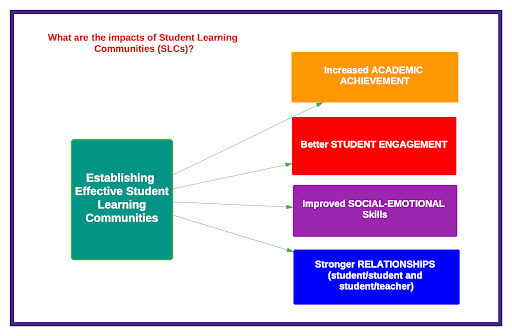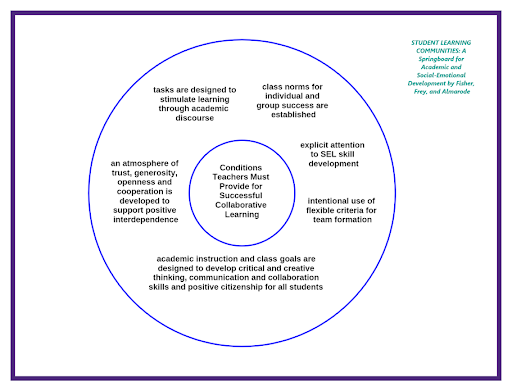The Student Learning Community: Strategies for Success
SEPTEMBER 12, 2022
We’ve talked about the importance of strong professional learning communities (PLCs). But what about student learning communities (SLCs)?
Cooperative and collaborative learning have been linked to both higher academic achievement and improved social skills for K-12 students. To get the most benefit from group learning, teachers need to build strong student learning communities in the classroom. Thinking Maps provide a shared “language for learning” to support SLCs and amplify the benefits of collaborative learning.

What is a Student Learning Community
A Student Learning Community (SLC) is a learning environment that connects students with each other and with teachers, parents and other collaborators in the learning experience. It transcends transitory
“group work” by creating a community organized around shared learning goals. Learning within an SLC is an ongoing, collaborative and dynamic process built on trust, accountability and active participation. Collaboration in this context is a core part of the learning process, not a “special” activity to be engaged in once in a while.
SLCs support higher levels of engagement and connection for students—which translates to better attendance, more active participation in learning, and stronger learning outcomes. In STUDENT LEARNING
COMMUNITIES: A Springboard for Academic and Social-Emotional Development, Fisher, Frey and Almarode outline the essential conditions that must be met to support successful collaborative learning within the SLC, including:
- An atmosphere of trust, openness and cooperation.
- Explicit attention to social-emotional learning (SEL) skills.
- Creation of class norms for individual and group success.
- Instruction designed to develop critical and creative thinking and communication skills.
- Tasks designed to stimulate learning through academic discourse.
- Flexible criteria for group formation depending on the task involved.

Building a Common Language for Learning in the SLC
Thinking Maps supports SLCs by providing a common language for learning that supports the growth of both academic and social-emotional skills. Using Thinking Maps for cooperative learning within the context of an SLC gives students a framework for gathering information, sharing ideas, and participating in formal academic discourse. Instead of “reinventing the wheel” for each new group assignment, students can focus on the actual content and learning, using portable, flexible learning tools that can be applied to many kinds of group work and learning activities.
- For example, “Think-Pair-Share” is a common collaborative learning strategy, in which students are given a learning task, provided an opportunity to learn independently, and then paired with another student to share and build upon each other’s ideas. Thinking Maps are ideal for this kind of activity. Students can create individual Thinking Maps, using the Map most appropriate for the learning task, and then pair up to compare and add to their Maps. The “Map-Move-Map” Thinking Map exercise provides a variation on Think-Pair-Share that incorporates movement.
- For another common collaborative learning method, Jigsaw, students are assigned to groups, each with a different topic to research or passage to read, and then “remixed” to share their learning with students from other groups. Students in each group can work collaboratively to create a Thinking Map appropriate for the information they are responsible for learning. When students reform into their new groups, they can “talk off the Map” to explain what they have learned to others.
- For “Round Robin” or “Carousel” activities, Thinking Maps provide a vehicle for shared meaning making. Instead of jumping immediately to a written product, students can create shared Thinking Maps that are passed between students or groups, with more information added at each pass. (See the “Sneak-a-Peak” activity in the Language for Learning manual, p. 227.
In these activities, Thinking Maps support and amplify common collaborative learning methods. Critically, Thinking Maps allow all students to participate effectively, including students learning English as a second language, students with learning disabilities, and students with different academic and cultural backgrounds. Everyone can contribute to building a Thinking Map in their own way. Thinking Maps provide a natural method for scaffolding and differentiation to help all students participate successfully in collaborative learning.
Looking for More SLC Tips?
The September Navigator (for Thinking Maps Learning Community members only) has a three-part series on SLCs. If you’re not a TMLC subscriber, contact your representative to get started.
- Student Learning Communities
- The Thinking Maps Flexible Grouping Connection
- TMLC Resources for Student Learning Communities
We also love these resources.
- STUDENT LEARNING COMMUNITIES: A Springboard for Academic and Social-Emotional Development (Fisher, Frey and Almarode; ASCD)
- Limitations/Problems with Cooperative Learning (K12 Academics)
- How Cooperative Learning Can Benefit Students This Year (Willis; Edutopia)
- Cooperative Learning in the K-12 Classroom (KNILT)
- Building Meaningful Community (Thomas; Edutopia)
- Group Work: Using Cooperative Learning Groups Effectively (Brahm and Biel; Vanderbilt University Center for Teaching)
Want to learn more about using Thinking Maps to build strong Student Learning Communities? Talk to your representative or check out our upcoming Virtual Training Calendar.
Continue Reading
July 2, 2025
A Meta-Analysis of studies showed that coaching, along with group training, curricular and instructional resources made a larger impact on the effects of teaching and student achievement.
June 16, 2025
At Thinking Maps, we are committed to creating a platform that not only meets but exceeds the expectations of our users. That’s why we’re thrilled to roll out a host of new user experience updates to the Thinking Maps Learning Community (TMLC). These updates represent a significant leap forward in usability, design, and functionality, ensuring a seamless and engaging experience for all users.
May 29, 2025
When it comes to professional learning for teachers, coaching has emerged as an effective method for fostering meaningful, long-term change in teaching practices. By offering personalized support, ongoing feedback, and practical application, coaching meets teachers where they are and provides the tools they need to thrive.
March 19, 2025
When we align instruction with the way the brain prefers to receive information, we can reduce the “cognitive load” of learning and help students maximize understanding, retention and recall. These six brain-based strategies can help educators improve learning outcomes and make learning more fun and efficient.